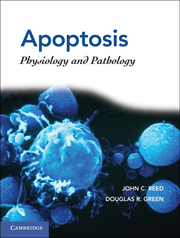Book contents
- Frontmatter
- Contents
- Contributors
- Part I General Principles of Cell Death
- Part II Cell Death in Tissues and Organs
- Part III Cell Death in Nonmammalian Organisms
- 33 Programmed Cell Death in the Yeast Saccharomyces cerevisiae
- 34 Caenorhabditis elegans and Apoptosis
- 35 Apoptotic Cell Death in Drosophila
- 36 Analysis of Cell Death in Zebrafish
- Plate section
- References
36 - Analysis of Cell Death in Zebrafish
from Part III - Cell Death in Nonmammalian Organisms
Published online by Cambridge University Press: 07 September 2011
- Frontmatter
- Contents
- Contributors
- Part I General Principles of Cell Death
- Part II Cell Death in Tissues and Organs
- Part III Cell Death in Nonmammalian Organisms
- 33 Programmed Cell Death in the Yeast Saccharomyces cerevisiae
- 34 Caenorhabditis elegans and Apoptosis
- 35 Apoptotic Cell Death in Drosophila
- 36 Analysis of Cell Death in Zebrafish
- Plate section
- References
Summary
Introduction
Although the fruit fly Drosophila melanogaster and the small nematode worm Caenorhabditis elegans have been crucial for advancing our understanding of the molecular mechanisms of cell death, there is a need for vertebrate model organisms to accelerate studies of human disease biology. A valuable vertebrate model system is the mouse Mus musculus, but this system suffers from the drawbacks of small litter sizes and in utero development. With these limitations in mind, zebrafish can provide unique advantages for in vivo experiments in a vertebrate model system to dissect conserved signal transduction pathways. In this chapter, we describe the zebrafish Danio rerio as a very useful vertebrate model system for studying cell death processes in both embryos and adults. First, we detail the advantages of the zebrafish animal model for discovering and analyzing cell death regulators. Second, we summarize a few studies in the field that have delineated distinct cell death mechanisms. Next, we highlight studies of developmental cell death and the very cancer-relevant p53 pathway in zebrafish, and we finish with some perspectives on the future of this exciting field of research. We hope to convey both a basic understanding of the strengths of this system and an overview of the important studies to date, which have enhanced our knowledge of the mechanisms that cells use to self-destruct when triggered by either developmental or environmental cues.
- Type
- Chapter
- Information
- ApoptosisPhysiology and Pathology, pp. 412 - 421Publisher: Cambridge University PressPrint publication year: 2011
References
- 1
- Cited by

